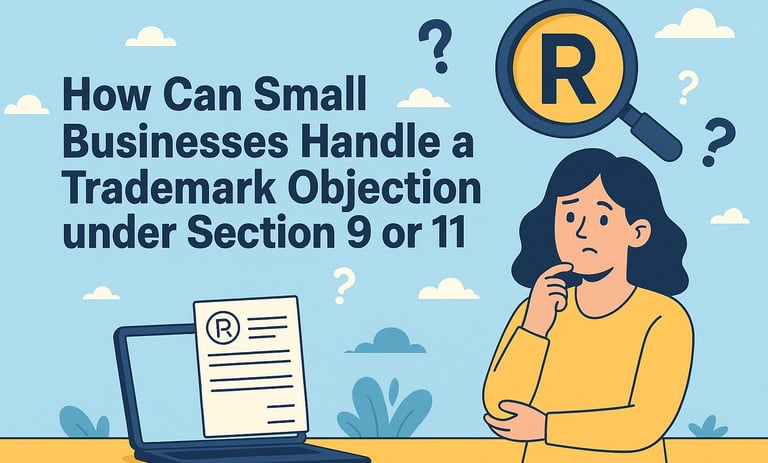How can small businesses handle a Trademark objection under section 9 or section 11 in India
This article guides small enterprises in India on overcoming trademark objections under Sections 9 and 11 to protect brand identity.
IPR
Shristy
6/24/20254 min read


Trademark objections can challenge small businesses during registration, often citing Sections 9 and 11 of the Indian Trademark Act. Knowing how to respond with clear explanations and evidence is essential for overcoming these hurdles and securing trademark protection.
What is a Trademark Objection
A trademark objection is an initial step in the trademark registration process, where the trademark examiner raises concerns regarding a trademark application for specific reasons. These objections are primarily based on Section 9, which outlines the absolute grounds for refusing trademark registration, or Section 11, which addresses the relative grounds for refusal. Essentially, the trademark examiner seeks a valid written explanation from the applicant regarding the mark in question and its eligibility for registration.
What is a Trademark Objection Reply
After receiving an objection from the trademark examiner, there is a specific time limit mentioned in the Notice within which you must reply with reasons and a satisfactory answer to the examiner.
Reasons for Trademark Objections
Absolute grounds
Trademarks play a crucial role in distinguishing the goods and services of one business from those of another. They help protect the legitimate interests of producers and manufacturers, safeguarding their reputation in the marketplace. However, certain absolute grounds may prevent registration based on public policy considerations. For instance, trademarks that lack distinctiveness, as well as indicative or descriptive marks—those that highlight quantity, quality, or intended purpose—can be considered common language or trade usage. Additionally, marks that are deceptive or may create confusion are also restricted from registration. This framework ensures that trademarks remain effective in identifying and promoting the unique offerings of businesses.
Relative grounds
According to Section 11 of the Trademark Act 1999, registration may be denied if the proposed trademark is likely to confuse the public due to its similarity to a previously registered mark. Additionally, if the new mark could mislead consumers regarding the origin of goods and services, take unfair advantage of the reputation of a well-known mark, or if it is prohibited from being registered in India, it may be refused. However, in cases of Honest Concurrent Prior Usage, where both marks are used in good faith, the process of registration should proceed, as this allows for fair competition and respects the rights of all parties involved.
Arguments against Trademark Objection raised under section 9 or section 11 of the Trademark Act in India.
Section 9 of the Trademark Act
If a user affidavit is not filed and the application is under a proposed trademark, then after filing the user affidavit, it is important to show the differences between the goods and services. Any evidence gathered should be verified using Google and other reputable sources.
If the user affidavit has been filed, evaluate the generic words within the trademark. Explain to the examiner that only a portion of the applicant's mark is descriptive when considered as a whole. It's important to note that only a part of the trademark may be descriptive, which could lead to dilution, and the applicant does not claim any exclusive rights over that descriptive part.
When reviewing the goods and services, it should be noted that marks can generally be descriptive. While the words may be indicative and potentially distinctive, they might not necessarily describe the goods and services provided by the applicant.
Stating a particular reason behind adopting a name, this might include a backstory such as the mark has been used for many years and has been recognizable in the public by this name only, any other name would harm their market.
Section 11 of the Trademark Act
Under the relative grounds outlined in Section 11 of the Trademark Act, an applicant may be barred from registration under Section 11(2). This applies if the proposed mark is identical to or similar to an earlier trademark, or if the proposed mark is to be registered for goods or services that are not similar to those for which the earlier trademark is registered, in the name of a different owner. Additionally, under Section 11(3), a mark cannot be used if it is prohibited by laws regarding passing off or copyright.
The applicant should check official trademark websites to select the application number related to the opposition. They need to verify whether the mark has been registered and gather information about the applicant. It’s important to note that even a registered mark may have various loopholes that could support arguments against the opposition.
The applicant should also differentiate between a word mark and a device mark, and consider the classification of goods and trade channels involved.
Furthermore, the applicant needs to assess the target audience for both their goods and services and those of the opposition. This is crucial because the consumers might belong to a particular socioeconomic class that can afford the goods or services, rather than simply being available to all demographics. Highlighting these differences can help address the objections raised.
Moreover, if the objection has been filed by a person who has established goodwill and is well-known before the applicant, the applicant should consider initiating cancellation proceedings against the application.
If the applicant is struggling to defend their trademark registration effectively, they should investigate the status of the objector's registration. If it is found to be inactive, the applicant could approach the proprietor for consent to continue the registration process. Alternatively, the applicant could negotiate to pay a certain amount to the proprietor for a license to use the trademark and subsequently transfer it to themselves.
The applicant can also modify the description of their goods and services after reviewing similar trademark descriptions.
In Conclusion, by carefully addressing objections with well-prepared arguments and understanding legal provisions, small businesses can successfully navigate trademark disputes and safeguard their unique brand presence in the market.
